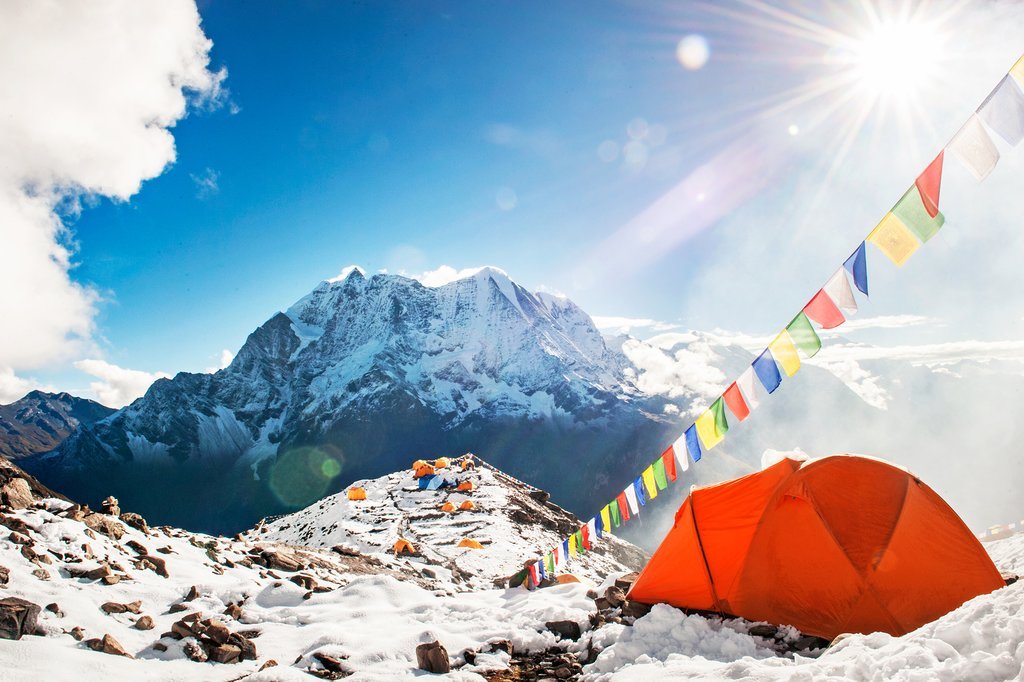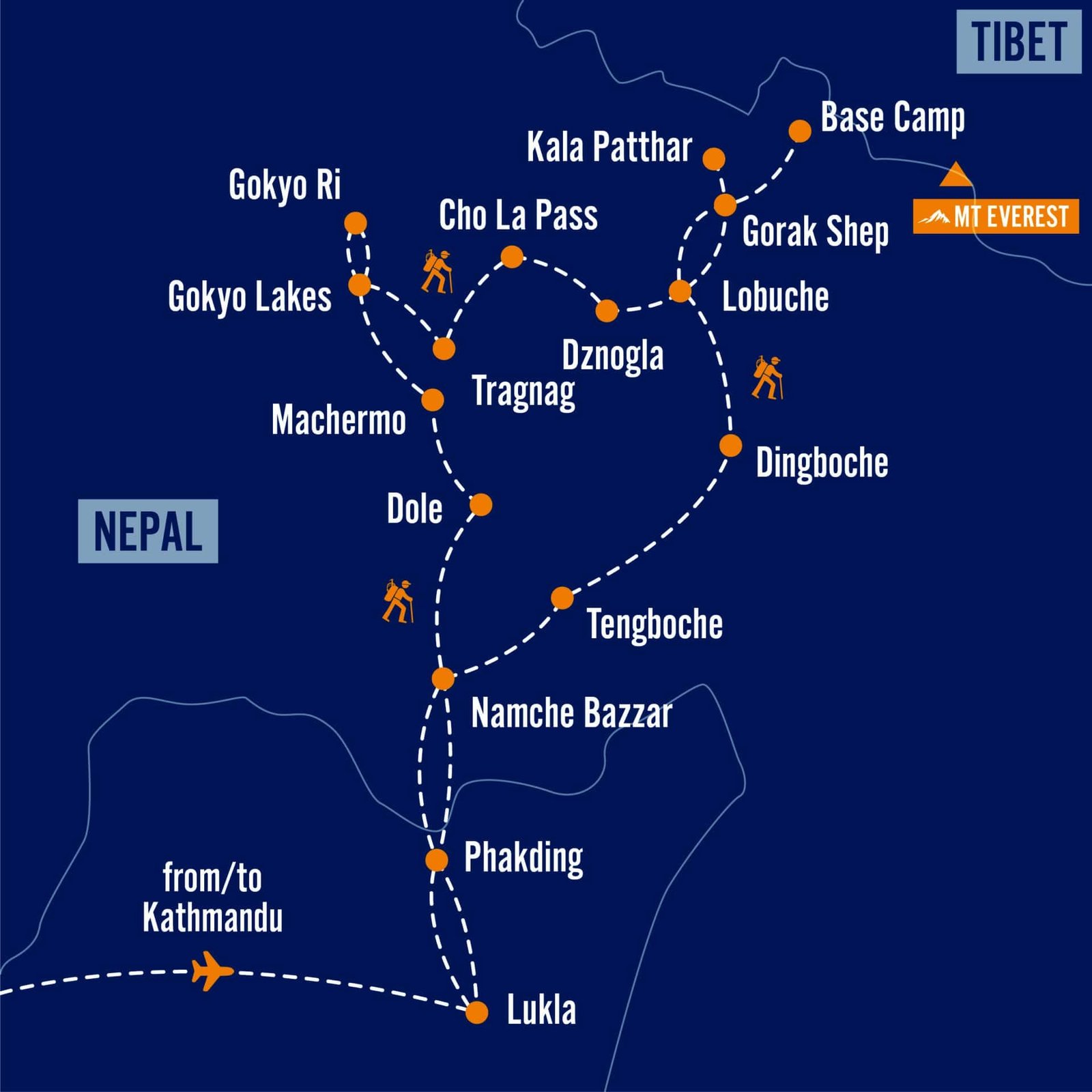Embarking on the exhilarating journey to Mount Everest Base Camp entails venturing into a realm of extreme altitude, where the air is thin and the body’s physiology undergoes significant adaptations. Understanding the elevation of this iconic location is paramount in appreciating the challenges and adaptations required for a successful expedition.

Everest Base Camp, nestled at a staggering altitude of 5,364 meters (17,598 feet) above sea level, falls within the Earth’s “death zone.” This formidable elevation presents several physiological hurdles for trekkers and mountaineers. The most immediate challenge is the reduction of atmospheric pressure, which directly impacts the partial pressures of oxygen and other gases in the air.

At sea level, the atmospheric pressure exerts a force of approximately 101.3 kilopascals (kPa). However, as altitude increases, the atmospheric pressure drops precipitously, reaching a mere 53.3 kPa at Everest Base Camp. This drastic decrease in pressure leads to a corresponding reduction in the partial pressure of oxygen, which is the driving force for oxygen uptake by the lungs.

Consequently, the body must work harder to extract oxygen from the rarefied air. The heart rate and respiratory rate increase to compensate for the reduced oxygen availability, leading to increased energy expenditure and a heightened sense of exertion. Additionally, the body triggers a physiological response known as acclimatization, which involves several adaptations to enhance oxygen delivery to tissues.
Red blood cell production increases, boosting the blood’s oxygen-carrying capacity. The body also produces more hemoglobin, a protein within red blood cells responsible for transporting oxygen. These adaptations help improve oxygen delivery, albeit gradually, allowing the body to better function at high altitudes.
However, the process of acclimatization takes time and requires a gradual ascent to allow the body to adapt. Rapid ascent without proper acclimatization can lead to altitude sickness, a potentially life-threatening condition characterized by headaches, nausea, vomiting, and impaired coordination. In severe cases, high-altitude cerebral edema (HACE) or high-altitude pulmonary edema (HAPE) can develop, leading to coma or even death.
Therefore, it is crucial for trekkers and mountaineers to ascend gradually, allowing the body time to acclimatize to the decreasing atmospheric pressure and oxygen levels. Proper hydration, nutrition, and rest are also essential to support the body’s physiological adjustments.
Comprehending the unique challenges of Everest Base Camp’s elevation enables trekkers and mountaineers to appreciate the significance of acclimatization and the importance of a measured approach to reaching this iconic destination. With careful planning, adequate preparation, and a deep understanding of the physiological demands of high altitude, adventurers can safely and successfully navigate the path to Everest Base Camp, cherishing the awe-inspiring beauty of the world’s highest peak.# High-altitude Health: Understanding Everest Base Camp’s Elevation
Executive Summary
Everest Base Camp (EBC), located at an elevation of 5,364 meters (17,598 feet), presents unique challenges to trekkers and climbers due to its high altitude. This article delves into the physiological effects of altitude on the human body, focusing on EBC’s elevation, and provides essential information for those planning a trek to the iconic base camp.
Introduction
As you embark on the challenging journey to Everest Base Camp, it is crucial to understand the impact of altitude on your body. At an elevation of over 5,000 meters, EBC poses significant physiological challenges that trekkers must be prepared for. This article explores the effects of high altitude on the human body and provides vital tips to ensure a safe and enjoyable trek.
Altitude and Its Effects on the Human Body
At sea level, the Earth’s atmosphere exerts a pressure of about 1 atmosphere (atm). As you ascend in altitude, the atmospheric pressure decreases, leading to a reduction in the partial pressure of oxygen (PO2) available for breathing. This decrease in PO2 triggers several physiological responses in the body:
- Hypoxia: The reduced oxygen levels at high altitudes lead to hypoxia, a condition where the body’s tissues are deprived of sufficient oxygen.
- Increased Respiratory Rate: The body compensates for hypoxia by increasing the respiratory rate, allowing more oxygen to enter the lungs.
- Increased Heart Rate: The heart rate also increases to pump more oxygenated blood to the body’s vital organs.
- Vasodilation: Blood vessels dilate to allow more blood flow to the vital organs, resulting in lower blood pressure.
- Production of Red Blood Cells: The body produces more red blood cells to carry more oxygen.
Subtopics
1. Acclimatization to High Altitude
Acclimatization is the process by which the body gradually adjusts to the reduced oxygen levels at high altitudes. This process typically takes several days or weeks and involves physiological and behavioral adaptations.
- Gradual Ascent: Gradually ascending to higher altitudes allows the body to adapt to the changing oxygen levels.
- Hydration and Proper Nutrition: Staying hydrated and consuming a healthy diet rich in carbohydrates and essential nutrients is crucial for acclimatization.
- Adequate Rest: Adequate rest and sleep are essential for the body to repair itself and recover from the physical demands of high altitude trekking.
- Monitoring Symptoms: It is essential to be aware of and monitor symptoms of altitude sickness, such as headache, nausea, vomiting, and shortness of breath.
2. Altitude Sickness
Altitude sickness refers to the complex of symptoms that can occur when ascending to high altitudes too rapidly or without proper acclimatization. These symptoms range from mild discomfort to life-threatening conditions.
- Mild Altitude Sickness (AMS): AMS is the most common form of altitude sickness and typically presents with symptoms such as headache, nausea, vomiting, and difficulty sleeping.
- High Altitude Cerebral Edema (HACE): HACE is a more severe form of altitude sickness that affects the brain and can lead to confusion, disorientation, and loss of consciousness.
- High Altitude Pulmonary Edema (HAPE): HAPE is a severe form of altitude sickness that affects the lungs and can lead to shortness of breath, coughing, and frothy sputum.
- Prevention: Proper acclimatization, gradual ascent, and monitoring symptoms are essential for preventing altitude sickness.
3. Hydration and Nutrition
Maintaining adequate hydration and consuming a healthy diet are crucial for trekkers at high altitudes. Dehydration and inadequate nutrition can exacerbate altitude sickness and compromise overall health.
- Hydration: Drink plenty of fluids, preferably water or electrolyte-rich beverages, to avoid dehydration.
- Healthy Diet: Consume a balanced diet rich in carbohydrates, proteins, and essential nutrients to provide the body with the energy and resources it needs at high altitudes.
- Avoid Alcohol and Caffeine: Alcohol and caffeine have diuretic effects and can contribute to dehydration.
4. Safety and Precautionary Measures
Trekking at high altitudes involves inherent risks, and trekkers must take necessary precautions to ensure their safety.
- Thorough Preparation: Proper planning, research, and selection of appropriate gear and equipment are crucial.
- Acclimatization: Gradual acclimatization is essential for reducing the risk of altitude sickness.
- Trained and Experienced Guides: Trekking with trained and experienced guides who are familiar with the terrain and conditions is highly recommended.
- Emergency Preparedness: Carry a first aid kit and be prepared to respond to emergencies.
5. Mental and Emotional Well-being
Trekking at high altitudes can be physically and mentally challenging. Maintaining mental and emotional well-being is crucial for a successful trek.
- Managing Expectations: Be realistic about your abilities and limitations, and avoid pushing yourself too hard.
- Positive Mindset: Maintain a positive mindset, embrace the challenges, and focus on the beauty of the surroundings.
- Embrace the Journey: Enjoy the journey and appreciate the unique experiences that high-altitude trekking offers.
Conclusion
Everest Base Camp, with its high elevation, presents unique challenges to trekkers due to the reduced oxygen levels and the physiological effects of altitude. Understanding these effects and taking necessary precautions, such as gradual acclimatization, proper nutrition and hydration, and monitoring symptoms, is essential for a safe and enjoyable trek. By following these guidelines and adopting proper safety measures, trekkers can mitigate the risks associated with high-altitude trekking and make the most of their journey to Everest Base Camp.
Keyword Phrase Tags:
- Everest Base Camp Elevation
- Altitude Sickness and Prevention
- Acclimatization for High Altitude Trekking
- Nutrition and Hydration at High Altitudes
- Safety Precautions for High-Altitude Trekking